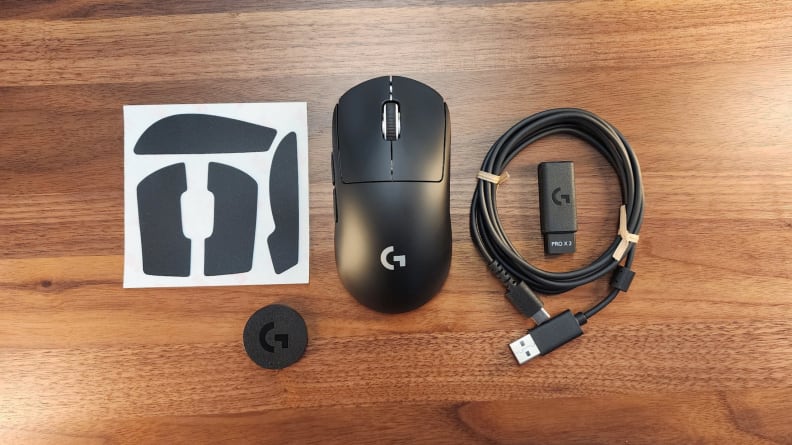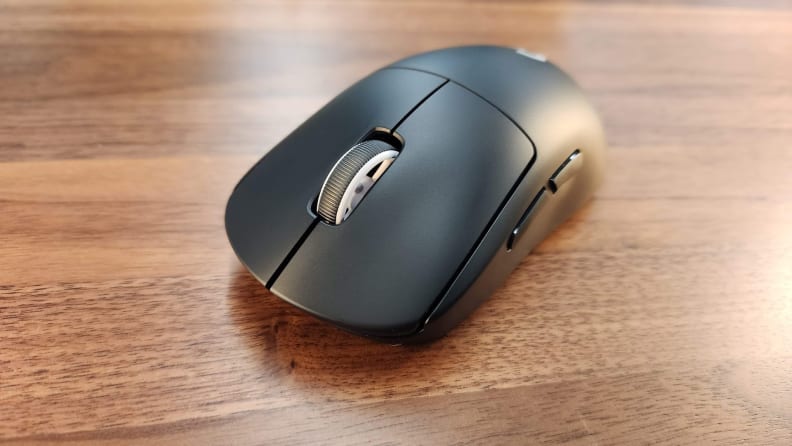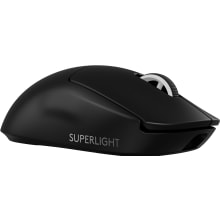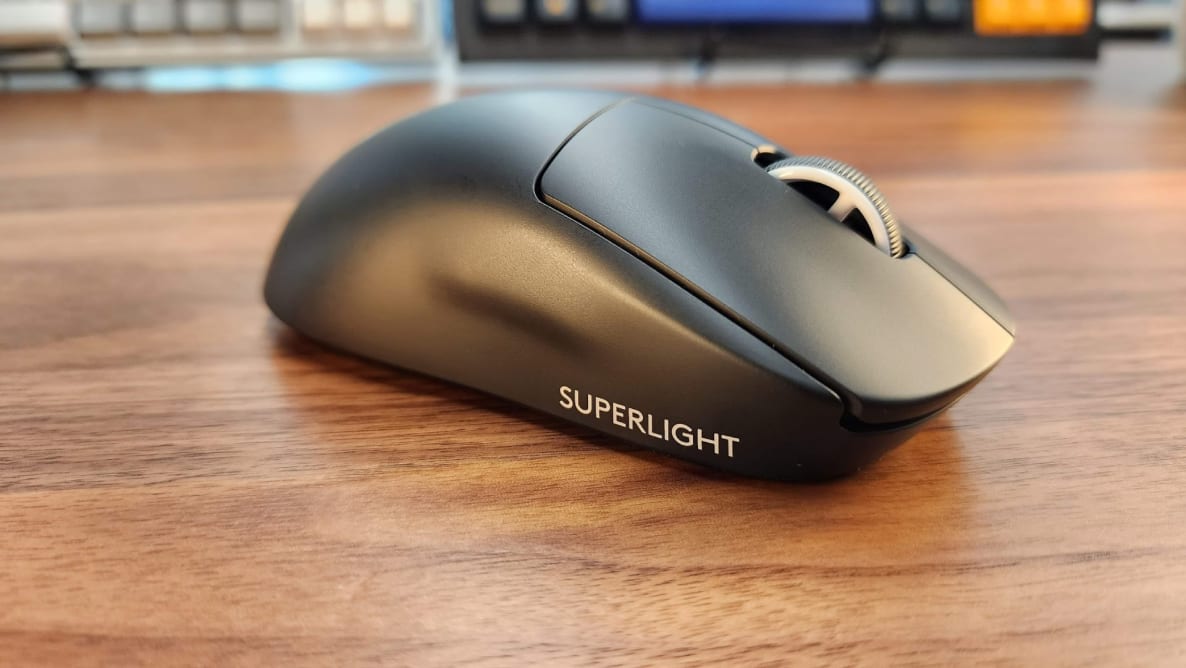Pros
-
Lightweight and ergonomic
-
Great new hybrid switches
-
Good battery life
Cons
-
Feels more like a refresh
-
No DPI button
-
Poor cable
About the Logitech G Pro X Superlight 2

The Logitech G Pro X Superlight 2 comes with optional grip tape.
- Price: $160
- Connectivity: USB Type-C to Type-A (detachable), 2.4GHz Wireless via USB-A dongle
- Dimensions: 4.9 x 2.5 x 1.6 inches
- Weight: 60 grams (2.12 ounces)
- Sensor: 32,000 DPI HERO 2 Optical Sensor
- Battery life: Up to 95 hours over 2.4 GHz wireless
- Buttons: 5 buttons
- Material: Plastic
- Colors: Black, white, magenta
- Cable: 6.5 feet, rubber-coated
- Special Features: Hybrid optical-mechanical switches, 2,000Hz polling rate, PowerPlay wireless charging compatible
At first glance, you may not be able to tell a difference between the original Logitech G Pro X Superlight and the Superlight 2. The shape is completely unchanged. Both are symmetrical but right-handed, five button mice; the only visual difference is the move to USB Type-C. The new model is a hair lighter, weighing in at 60 grams versus the 63 of the original. They both also still support wireless charging with Logitech's Powerplay mat.
The new model features the company’s Hero 2 sensor, which bumps the maximum DPI from 25.6K to 32K, the max speed to 500 inches per second (IPS), and keeps acceleration the same at 40G. This model also increases the maximum polling rate to 2,000Hz, drops latency to 0.5ms, a boon for esports. Battery life has also gone up to 95 hours, up from 70 hours on the original.

The Logitech G Pro X Superlight 2 features a highly accurate sensor and amply-sized glide skates.
The Superlight 2 also adopts the optical-mechanical Lightforce switches that debuted with the Logitech G502 X. These switches combine an optical click detection with a mechanical clicker to provide exceptional responsiveness with satisfyingly tactile feedback.
The temptation with a mouse like the Logitech G Pro X Superlight 2 is to write it off as more of the same. Logitech didn’t put much effort into updating the look, even keeping the same “Superlight” branding on the side, and the shell is exactly the same. But it’s important to remember that the Superlight series is purpose-built for esports and has been popular among athletes and aspirants since its release, so changing the shape could be a bad thing.
Logitech played it safe, but at worst that means is that it's not exciting. It continues to be a great gaming mouse for claw and fingertip grips. It’s a medium-sized mouse with a higher rear contour than competitors like the Razer Viper V2 Pro, but is still low profile enough that palm grip players are better suited elsewhere.
The updates keep its performance near peak potential rather than change how it actually feels to use. The updated sensor (free of any smoothing or filtering that could decrease accuracy) now has an even loftier DPI range that’s better suited to low sensitivity, high DPI first-person shooter gameplay thanks to its improved top speed. As a casual but longtime player of first-person shooters, I struggled to tell a difference in tracking accuracy; both it and the original were about as perfect as gaming mice come. The HERO 2 sensor is technically more capable, however, so if you’re a pro or pro-aspiring, it’s the one to choose.
Much more meaningful to me were the new switches and faster polling rate. The switches have a defined click that’s among the best I’ve ever felt. They’re also faster (on paper), as the optical sensor lacks the debounce delay found on mechanical switches, meaning that inputs are sent measurably quicker than mechanical switches, albeit in milliseconds.
The increased polling rate (how many times per second your PC checks for input) is perhaps the most meaningful update of all, as the decreased latency makes the mouse feel more responsive, especially in critical moments as enemies are ducking in and out of sight. It’s important to note, though, that these are enhancements you really have to be sensitive to.
Over the week, I played multiple rounds of Call of Duty: Modern Warfare 2, Battlebit Remastered, and Battlefield 2042. Since the shape is identical to the original and so traditional overall, there was virtually no learning curve. The mouse tracked perfectly and felt natural in my hand.
Compared to the Razer Viper V2 Pro or Asus ROG Harpe, it feels slightly bigger but also more accommodating to more relaxed grips for single-player games and web browsing. On 3D Aim Trainer's Tile Frenzy test, my scores were virtually untouched, averaging around 100 with all three.
The biggest drawback is a lack of DPI button. Pro gamers might not change DPI often but I missed it immediately and regularly, especially as this is a feature found on most other mice at every price point. The included cable also feels like it was pulled from 2010. While even lower cost competition now provide ultra-soft braided cables, the Superlight 2 still uses a basic rubberized cable that needs a mouse bungee (sold separately) to feel weightless.
Should you buy the Logitech G Pro X Superlight 2?
Yes, it’s a proven design with even better specs

Logitech listened to feedback: If the shape isn't broken, don't fix it.
I had almost forgotten how much I enjoyed the original Logitech G Pro X Superlight. Now, comparing it side by side with its successor and two of its biggest competitors, I have a rekindled appreciation for its simplicity and efficient design. It doesn’t offer many frills: this mouse is all about its proven shape and performance.
Because of that, it can also feel a little boring. If you’re not playing at a high level, the original Logitech G Pro X Superlight is still a good option that can usually be found for $130 and should only get less expensive over time. The Razer Viper V2 Pro is another excellent option with very similar features and a lower profile shape. The HyperX Pulsefire Haste 2 is an even more affordable option that scales back the sensor to 26,000 DPI and uses mechanical switches but can usually be found for $70. It also has Bluetooth.
The Logitech G Pro X Superlight 2 is the successor to a classic. It has top-tier specs, a proven shape, and a dedicated fanbase that have extolled the virtues of the original for several years running. It costs a bit more but is a safe bet if you’re looking for competitive performance.

A simple yet high-performing mouse that improves on its preecessor.
Meet the tester
Chris has been specializing in PC and audio-related tech since 2015. Find him at IGN, Tom's Hardware, PC Perspective, MMORPG.com, and more.
Checking our work.
Our team is here for one purpose: to help you buy the best stuff and love what you own. Our writers, editors, and lab technicians obsess over the products we cover to make sure you're confident and satisfied. Have a different opinion about something we recommend? Email us and we'll compare notes.
Shoot us an email



